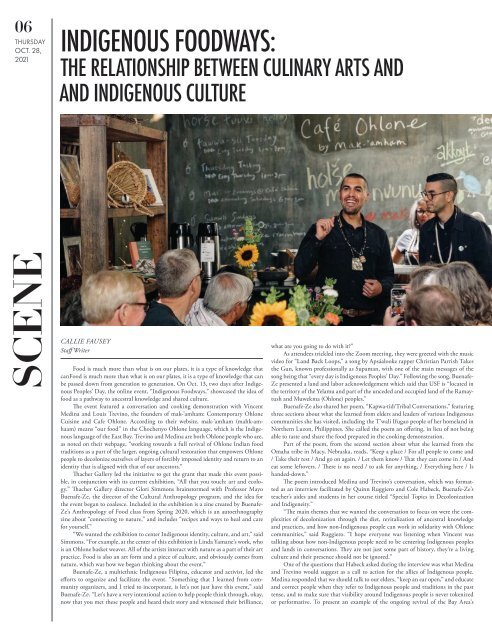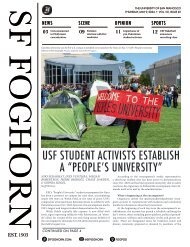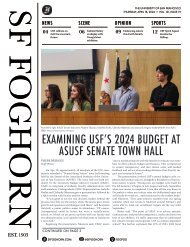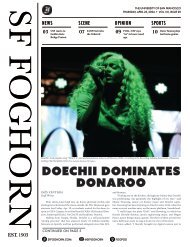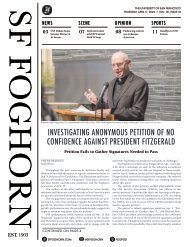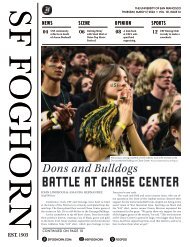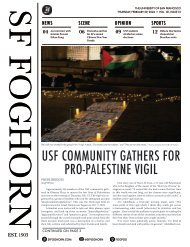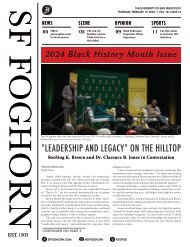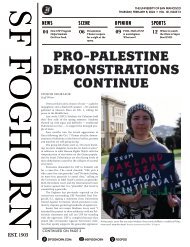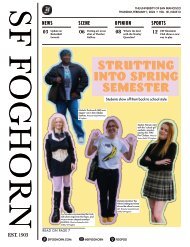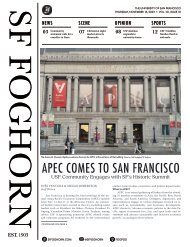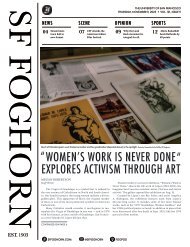VOL 119, Issue 7—Oct. 28, 2021
Create successful ePaper yourself
Turn your PDF publications into a flip-book with our unique Google optimized e-Paper software.
06<br />
THURSDAY<br />
OCT. <strong>28</strong>,<br />
<strong>2021</strong><br />
INDIGENOUS FOODWAYS:<br />
THE RELATIONSHIP BETWEEN CULINARY ARTS AND<br />
AND INDIGENOUS CULTURE<br />
Vincent Medina and Louis Trevino, the presenters for the Indigenous<br />
Foodways event on Oct. 13, speak at their restaurant, Cafe<br />
Ohlone. PHOTO COURTESY OF MAYO BUENAFE-ZE<br />
07<br />
SCENE<br />
CALLIE FAUSEY<br />
Staff Writer<br />
Food is much more than what is on our plates, it is a type of knowledge that<br />
canFood is much more than what is on our plates, it is a type of knowledge that can<br />
be passed down from generation to generation. On Oct. 13, two days after Indigenous<br />
Peoples’ Day, the online event, “Indigenous Foodways,” showcased the idea of<br />
food as a pathway to ancestral knowledge and shared culture.<br />
The event featured a conversation and cooking demonstration with Vincent<br />
Medina and Louis Trevino, the founders of mak-'amham: Contemporary Ohlone<br />
Cuisine and Cafe Ohlone. According to their website, mak-'amham (mahk-amhaam)<br />
means “our food” in the Chochenyo Ohlone language, which is the Indigenous<br />
language of the East Bay. Trevino and Medina are both Ohlone people who are,<br />
as noted on their webpage, “working towards a full revival of Ohlone Indian food<br />
traditions as a part of the larger, ongoing cultural restoration that empowers Ohlone<br />
people to decolonize ourselves of layers of forcibly imposed identity and return to an<br />
identity that is aligned with that of our ancestors.”<br />
Thacher Gallery led the initiative to get the grant that made this event possible,<br />
in conjunction with its current exhibition, “All that you touch: art and ecology.”<br />
Thacher Gallery director Glori Simmons brainstormed with Professor Mayo<br />
Buenafe-Ze, the director of the Cultural Anthropology program, and the idea for<br />
the event began to coalesce. Included in the exhibition is a zine created by Buenafe-<br />
Ze’s Anthropology of Food class from Spring 2020, which is an autoethnography<br />
zine about “connecting to nature,” and includes “recipes and ways to heal and care<br />
for yourself.”<br />
“We wanted the exhibition to center Indigenous identity, culture, and art,” said<br />
Simmons. “For example, at the center of this exhibition is Linda Yamane’s work, who<br />
is an Ohlone basket weaver. All of the artists interact with nature as a part of their art<br />
practice. Food is also an art form and a piece of culture, and obviously comes from<br />
nature, which was how we began thinking about the event.”<br />
Buenafe-Ze, a multiethnic Indigenous Filipina, educator and activist, led the<br />
efforts to organize and facilitate the event. “Something that I learned from community<br />
organizers, and I tried to incorporate, is let's not just have this event,” said<br />
Buenafe-Ze. “Let's have a very intentional action to help people think through, okay,<br />
now that you met these people and heard their story and witnessed their brilliance,<br />
what are you going to do with it?”<br />
As attendees trickled into the Zoom meeting, they were greeted with the music<br />
video for “Land Back Loops,” a song by Apsáalooke rapper Christian Parrish Takes<br />
the Gun, known professionally as Supaman, with one of the main messages of the<br />
song being that “every day is Indigenous Peoples’ Day.” Following the song, Buenafe-<br />
Ze presented a land and labor acknowledgement which said that USF is “located in<br />
the territory of the Yelamu and part of the unceded and occupied land of the Ramaytush<br />
and Muwekma (Ohlone) peoples.”<br />
Buenafe-Ze also shared her poem, “Kapwa-tid/Tribal Conversations,” featuring<br />
three sections about what she learned from elders and leaders of various Indigenous<br />
communities she has visited, including the T’wali Ifugao people of her homeland in<br />
Northern Luzon, Philippines. She called the poem an offering, in lieu of not being<br />
able to taste and share the food prepared in the cooking demonstration.<br />
Part of the poem, from the second section about what she learned from the<br />
Omaha tribe in Macy, Nebraska, reads, “Keep a place / For all people to come and<br />
/ Take their rest / And go on again. / Let them know / That they can come in / And<br />
eat some leftovers. / There is no need / to ask for anything, / Everything here / Is<br />
handed-down.”<br />
The poem introduced Medina and Trevino’s conversation, which was formatted<br />
as an interview facilitated by Quinn Ruggiero and Cole Habeck, Buenafe-Ze’s<br />
teacher’s aides and students in her course titled “Special Topics in Decolonization<br />
and Indigeneity.”<br />
“The main themes that we wanted the conversation to focus on were the complexities<br />
of decolonization through the diet, revitalization of ancestral knowledge<br />
and practices, and how non-Indigenous people can work in solidarity with Ohlone<br />
communities,” said Ruggiero. “I hope everyone was listening when Vincent was<br />
talking about how non-Indigenous people need to be centering Indigenous peoples<br />
and lands in conversations. They are not just some part of history, they’re a living<br />
culture and their presence should not be ignored.”<br />
One of the questions that Habeck asked during the interview was what Medina<br />
and Trevino would suggest as a call to action for the allies of Indigenous people.<br />
Medina responded that we should talk to our elders, “keep an ear open,” and educate<br />
and correct people when they refer to Indigenous people and traditions in the past<br />
tense, and to make sure that visibility around Indigenous people is never tokenized<br />
or performative. To present an example of the ongoing revival of the Bay Area’s<br />
Indigenous languages, Medina shared a video of his niece reading from a children’s<br />
book in Chochenyo.<br />
“Louis and Vincent were sharing that Ohlone people are still here, and they’re<br />
doing amazing things in their community,” said Buenafe-Ze. “If you’re in a space<br />
where you’re hearing people talk about Indigenous peoples, make sure they’re talking<br />
about us in the present tense. Their presence and what the whole event was about is<br />
also such a powerful way to show representation, you now get to meet someone who<br />
not only is Ohlone, but knows how to cook Ohlone food, is learning the Chochenyo<br />
language, learning the Rumsen language, so you have very visceral examples of who<br />
Indigenous people are.”<br />
Another part of the discussion revolved around acorns and acorn soup. Medina<br />
mentioned that acorns are the centerpiece of their traditional diet and can be traced<br />
back through generations.<br />
“I think acorns also really are a metaphor for the resilience of our community,”<br />
Medina said. “Our elders today still make acorn soup in the old way. Those are<br />
things that we value in our culture, being intentional and being rooted in where we<br />
come from. Specific to our traditions, acorn soup is a comfort food.”<br />
The topic of traditional ingredients in Ohlone meals coincides with the concept<br />
of decolonization through our diets, which Buenafe-Ze described as a journey that<br />
looks different depending on one’s individual identity and heritage. “Decolonization<br />
does not look the same for everybody. We’ve all been colonized in different ways,”<br />
said Buenafe-Ze. “And with decolonizing our food, in the context Louis and Vincent<br />
were coming from, was how it was a reclamation of their ancestral knowledge that<br />
had been violently wiped out from the consciousness or memory of their communities.<br />
Reintroducing those foods to their community is that decolonizing act for<br />
them, because decolonization is an action to dismantle forms of colonialism.”<br />
For the cooking demonstration, Trevino and Medina made chia seed porridge,<br />
or “pattih,” an old time food in California. Medina mentioned that, “in the old<br />
days,” chia and other ingredients were gathered “primarily by women going out<br />
with beautiful burden baskets.” Trevino held each component of the dish up to the<br />
camera before returning it to his preparation table as he and Medina narrated the<br />
process. To accompany the porridge, they put together a blackberry and bay laurel<br />
sauce and made rose hip tea. Most of the ingredients they used, such as candied<br />
mushrooms and dried fruit, like chia, are native to California. “Our food, it looks<br />
like the land,” said Medina.<br />
Professor Mayo Buenafe-Ze, the<br />
director of USF’s Cultural Anthropology<br />
program, organized and<br />
hosted the Indigenous Foodways<br />
event online on Oct. 13<br />
PHOTO COURTESY OF MAYO<br />
BUENAFE-ZE.<br />
“A big takeaway for me was just how significant the process of obtaining ingredients<br />
and cooking food is, it’s just as important as actually eating food,” said Ruggiero.<br />
“That’s something I think we tend to forget in such a consumerist society, that<br />
our food actually came from somewhere, that every ingredient has a story behind it.”<br />
Many of the questions in the following Q&A had to do with sourcing ingredients,<br />
which, as emphasized by Buenafe-Ze, is “not gonna be as convenient as hitting<br />
up your local Whole Foods.”<br />
Medina explained that when gathering ingredients, such as acorns in the East<br />
Bay, the first drop has to be left for other life. He said that Ohlone people have “no<br />
word for famine because we always have enough,” but do have a word for having too<br />
much. They find ways to source ingredients that do not put stress on the land, and<br />
in order to be respectful of their homeland, sometimes substitute traditional Indigenous<br />
ingredients with more sustainable alternatives similar in taste.<br />
“As far as where we source our ingredients, we have to be innovative, because<br />
we can’t gather everything in the traditional way,” due to the colonial degradation of<br />
their homeland, Medina said. He continued that they source ingredients from places<br />
such as student organic gardening associations, grown by allies of their community<br />
and in home gardens, and develop relationships with local farmers. They also offered<br />
suggestions about modifications to the recipe for those without access to harder-tofind<br />
ingredients.<br />
“I felt really honored, like you’re being invited to somebody’s table,” Simmons<br />
said about the demonstration. “If I do and when I make it, I will be thinking about<br />
Vincent and Louis, their community, and the culture they shared.”<br />
Buenafe-Ze praised the cooking demonstrations' simultaneous simplicity and<br />
complexity, and said that it is a form of “Indigenous pedagogy.” She said that the<br />
intergenerational transfer of knowledge is a healing tool for their communities.<br />
“If you’re learning this stuff from Indigenous people, acknowledge who<br />
you got it from, and use that knowledge for the way it was intended,” said Buenafe-<br />
Ze. “Cooking is an experiential form of learning. It sits with you and it makes you<br />
kind of expand. What is your relationship with food, with the environment and<br />
with other people? It makes you think about all of those things at once. And that is<br />
inherently an Indigenous way of teaching and learning.”<br />
Cafe Ohlone is planned to reopen as a full-fledged restaurant in the courtyard<br />
of the Hearst Museum of Anthropology on the University of California, Berkeley<br />
campus by 2022.<br />
SCENE


